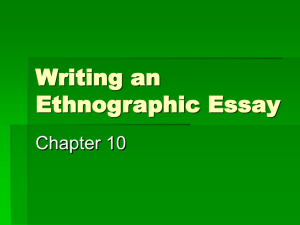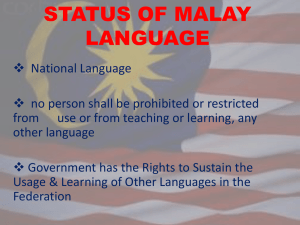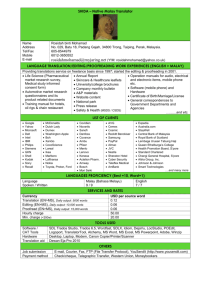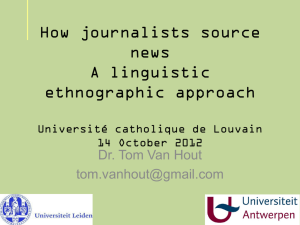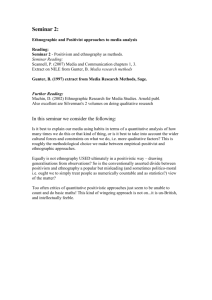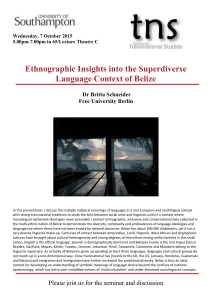Linguistic ethnography of policy and practice: L1 in English classroom interaction
advertisement
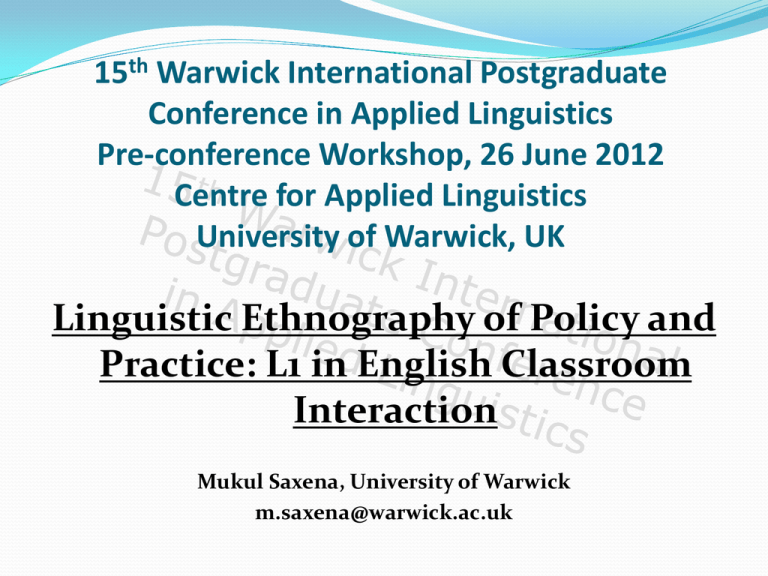
15th Warwick International Postgraduate Conference in Applied Linguistics Pre-conference Workshop, 26 June 2012 Centre for Applied Linguistics University of Warwick, UK Linguistic Ethnography of Policy and Practice: L1 in English Classroom Interaction Mukul Saxena, University of Warwick m.saxena@warwick.ac.uk The focus for this session At micro-level, it will focus on the transcripts of monolingual and bilingual interactional practices constructed in the moment in classrooms. At another level, it will draw on interview data to try to understand these interactional practices in the light of the attitudes of the participants towards the languages involved and their role in teaching and learning. At the macro-level, it will explore how the discourses reflected in participants’ attitudes are shaped by or challenge the broader policy level ideological factors. The research context 1960s to present: three ‘moments’ in the study of language policy. 1. The ‘rational’ approach to language planning 2. Critical approaches, including the historical-structural approach 3. Ethnographic approaches (some critical) The early research on language planning (1960s – late 1980s) Rooted in structural-functional thinking Multilingualism seen as a “problem that states have to solve” (Ricento & Hornberger, 1996) Choice of research methods guided by a positivist view of social science (e.g. attitude surveys) Primary reliance on quantitative data Critical approaches (late 1980s to the present) Draw on recent strands of social theory e.g. post-structuralism & post-modernism & critical theory Dominant strand: historical-structural approach (Tollefson, 1991) Major goals: (1.) “to examine the historical basis of policies” (1991: 32) and to show how policy decisions are tied to political & economic interests; (2.) to uncover the language ideologies underpinning policy decisions. Ethnographic approaches: unpeeling/slicing the policy ‘onion’ (mid 1990s to present) Emerging from linguistic anthropology (USA) and linguistic ethnography (Europe) Acknowledging advances of critical approaches but arguing for more attention to: “agents, levels & processes” in language policy & planning (Ricento & Hornberger, 1996: 408) Recent methods guided by the interpretive traditions in the social sciences (e.g. interviews, participant observation, analysis of bilingual talk) The layers of policy-making Policies change as they move down through administrative levels, either explicitly in new written documents or through interpretation of existing documents. Only the most authoritarian political structures leave little room for variation in the implementation of official language policy (Ricento & Hornberger, 1996:417) A focus for ethnographies of language policy We need to turn our attention to the specific ways in which policies are translated into practice and to the “intersticies where strategies of implementation have to be invented” (Heller, 1995: 70) “We place the classroom practitioner at the heart of language policy (at the center of the onion)” (Ricento & Hornberger, 1996: 417) Goals for language policy ethnography “To provide independent analysis and critique; so as to assess the limits and potential of existing provision” (Rampton, 1995) “To illuminate the complexity of language planning and policy processes and the ways in which they create or restrict ideological and implementational spaces for multilingual pedagogies” (Hornberger & Johnson, 2007: 510511) From language policy ‘on paper’ to classroom practice: English only Policy in English classrooms in Brunei An ethnographic approach combined with classroom discourse analysis Primary focus on two classrooms Observation, audio & video-recording & analysis of bilingual teaching/learning events in these classrooms Interviews with practitioners Multi-layered Analysis Analysis of classroom talk community practices at home & community Attitude towards L1 use in classroom Teachers, students & other stakeholders Interaction between broader ideologies of localisation & globalisation national ideology ideology of the English pedagogy (English-only ideology: L1 as ‘illegitimate’ or the ‘the problem Other’) Linking critical, historical & ethnographic perspectives An ethnography of language policy can include textual and historical analyses of policy texts but must be based in an ethnographic understanding of some local context. The texts are nothing without the human agents who act as interpretive conduits between the language policy levels (Hornberger & Johnson, 2007: 528). Case Study: Brunei Darussalam National Ideology: MIB Malay Islam Beraja Malay Islamic Monarchy According to Minnis (1999:172), the MIB ideology reconstructs Brunei’s history and invokes Islamic values in support of the Malay Sultanate and the monarchy. Consequently, an inextricable link between Malay ethnic identity, Malay culture, Malay language (the official/ national language), Islam and the nation is legitimized to achieve cohesion in this modern nation-state. Malay To uphold Brunei’s national identity, Brunei’s history, monarchical tradition and culture English modernisation, internationalisation & globalisation of Brunei Bilingual Education Policy Lower Primary (yr 1-3) : Malay medium; English & Standard Malay as subjects Upper Primary (yr 4) onwards: Language separation model Malay: Standard Malay, Civics (MIB), Brunei History, Religious Knowledge (Islam) and Physical Education & Arts Handicraft English: English, Maths, Science, Geography Communicative Practices in the Classroom & Attitudes: L1 as a Problem or Right? LITERACY EVENTS: Extract 1 : L1 as the “LINGUISTIC OTHER” in the classroom (Saxena, 2009) Extract 2: “ENGLISH” as the “LINGUISTIC OTHER” in the classroom (Saxena, 2009) Directive scaffolding (Saxena 2010) Verbatim quotations: 1-3 Communicative Practices in the Classroom & Attitudes: L1 as a Resource Extract 3: CONSTRICTIVE RESTISTANCE Negotiating local & global ideologies Verbatim quotations: 4-7 (Saxena, 2009) ----------------------------------------------- Extract 4 & 5: Supportive scaffolding (Saxena, 2010) The “resistance” shown by the students in their discourse in Classroom 1 can be termed “noncooperation” and aligned with the “language right” argument. A variation of this type of resistance is “constructive resistance”, … “Resistance may also sometimes transcend the whole phenomenon of beingagainst-something, turning into the proactive form of constructing ‘alternative’ or ‘prefigurative’ social institutions which facilitate resistance, i.e. ‘confrontative alternatives’ or ‘constructive resistance’...”. The resistance in this “constructive” sense may be seen as related to the “language as a resource” argument where the use of L1 in English classrooms is exploited positively in teaching-learning processes. (Saxena 2009) Linking critical, historical & ethnographic perspectives An ethnography of language policy can include textual and historical analyses of policy texts but must be based in an ethnographic understanding of some local context. The texts are nothing without the human agents who act as interpretive conduits between the language policy levels (Hornberger & Johnson, 2007: 528). LINGUISTIC ETHNOGRAPHY OF POLICY Language Policy from the top (legislation) ‘English-only’ ideology Language as a problem: Policing of English in the classroom (practice) ----- Directive scaffolding Language policy from below (practice) Code-switching practices in the classroom Language as a right: Challenge to teacher’s authority Non-cooperative resistance: Conflicting ideologies of tradition and modernity ----Directive scaffolding Language as a resource : Negotiation of ideologies Constructive resistance ----Supportive scaffolding
